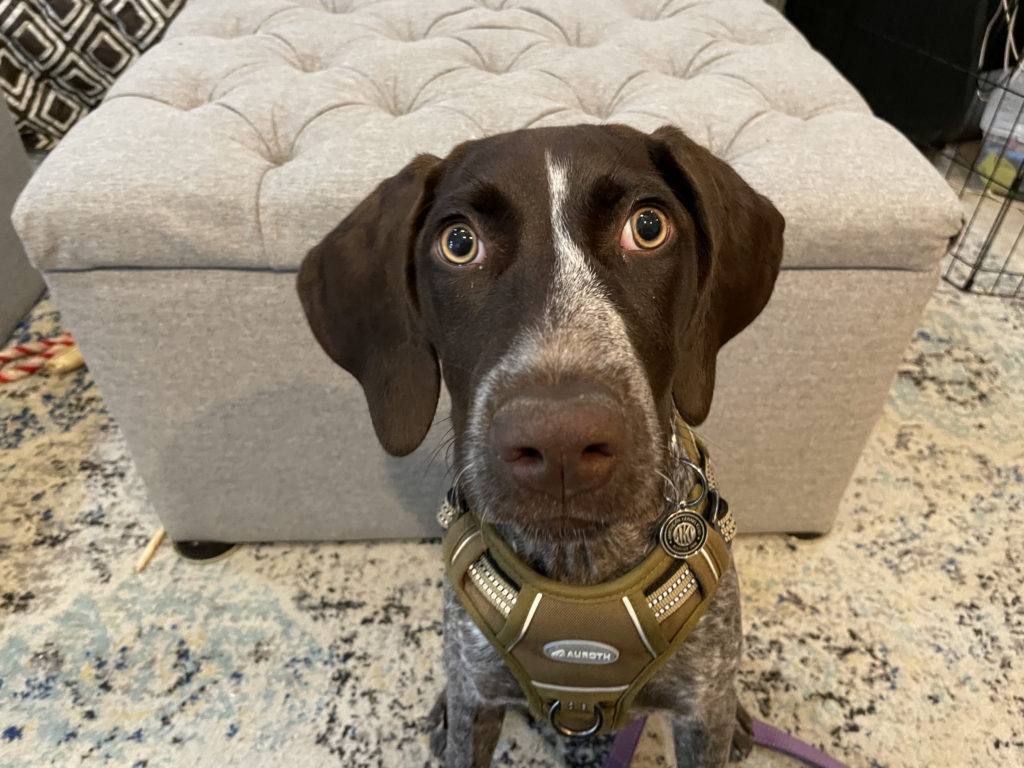Teaching a Puppy to Like the Long Term Confinement Area
By: David Codr
Published Date: December 14, 2021
For today’s LA dog training session we worked with Mochi, a six month old German shorthair pointer, training her to stay inside a long-term confinement area.
And when we were scheduling this session, I stressed the importance of getting Mochi signed up for an in person puppy training class. The word puppy training class is a little bit of a misnomer, really what you’re looking for is a puppy socialization class. A good puppy class allows puppies of a similar ages and sizes to play together to develop social skills and confidence.
Dogs and puppies learn far more social skills from interacting with one another in positive experiences than they do from humans. Training a dog is very different than developing its confidence, social skills and manners. Those are skills that are best introduced, practiced and perfected in the first year of a pup’s life.
Unfortunately, many people focus on training their puppy, which can be done at any time of a dogs life. Puppies have very little impulse control, are still exploring the world and have a very short attention span which causes a lot of frustration in humans who focus on training over socialization and building confidence. While it’s important to do some basic training with your puppy, creating positive social interactions is profoundly more beneficial.
The guardian had taken Mochi to a puppy class prior to our session, but there were a few elements in its structure that gave me pause. The instructor let the puppies play together first and then tried to teach them afterwards which I believe sets dogs up to fail. Once the puppy is in a room with another dog or pup that it gets to play with, it’s almost irresistible for them to want to continue the play. This is going to cause the puppy to not pay attention to the human and become frustrated. It’s also going to make the human frustrated because the pup is not listening.
I recommended that the guardians use their social media profiles to post cute pictures of Mochi to their friends and ask them to share it on their pages. The end goal is to find other puppies of a similar size and maturity level that live in the area. Our recommendation in our puppy classes is that a puppy meets five other puppies every week and has at least one play date (until its a year old, bt socializing after that is important too). It’s important that the socialization / playtime is positive for both dogs. Sometimes it’s important to give dogs timeouts to help them settle down and practcice reducing their energy level.
Since Mochi is a German shorthair pointer, I shared a number of creative ways of exercising the pup as well as the importance of mental stimulation. Feeding out of a snuffle mat and treat dispensing toys, regular short training sessions, positive play dates and some scent games are all great ways to help ensure that the dog has its needs taken care of.
I am a big believer in setting up a long-term confinement area when you bring a puppy into your home. I prefer to do this when the puppy is very young; 8 to 10 weeks. Having a safe secure area for your puppy to stay in when you cannot supervise it makes having a puppy so much easier.
A long-term confinement area or LTCA is also great at helping puppies practice being alone. But just like any other training method, you have to introduce it in a positive way and practice in order for a pup to like it. If you would like to set up a long-term confinement area for your puppy or need help in training your puppy to like being inside and LTCA, you’ll love the positive puppy training video below.
Training a puppy to enjoy being inside the LTCA requires practice. Just like exercise, it’s best done in shorter, more frequent practice sessions that happen throughout the day. The video also includes a number of other tips to train a dog to use a LTCA. I’d like to see the guardians practicing these LTCA training tips 4 to 8 times a day, if not more. But the quality of the practice is far more important than the quantity. They should avoid practicing with the LTCA when the room is busy or if the dog has a ton of energy.
We finished up the session by filming a roadmap to success video. This gave me the ability to summarize all of the puppy training tips we shared in this in home LA dog training session.
Categorized in: Dog Behavior


